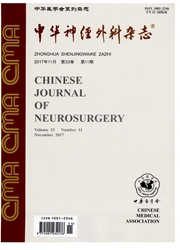

 中文摘要:
中文摘要:
目的应用细胞应力加载系统建立HT-22细胞损伤模型。方法采用Bioflex细胞培养板接种HT-22细胞,应用FX-5000TFL细胞应力加载系统进行牵张损伤(形变率为13.4%、频率为5.0Hz)。并按照时间的长短分为对照组和6、12、24h组。应用数字全息显微镜(DHM)动态检测细胞平均面积和平均厚度值,采用锥虫蓝染色法和乳酸脱氢酶(LDH)试剂盒检测细胞存活率和LDH的释放情况,并通过流式细胞术检测细胞周期和Sub-G1期峰的变化。结果(1)DHM检测结果显示:与对照组比较,损伤6h后HT-22细胞面积由(603.9±28.5)μm2降至(182.9±4.5)μm2(t=21.93,P〈0.01),细胞厚度由(4.0±0.2)μm升至(8.3±0.3)μm(t=16.65,P〈0.01)。(2)细胞存活率结果显示:对照组细胞存活率为(95.0±1.6)%,而损伤后6h[(59.7±4.5)%]较对照组显著下降(t=10.44,P〈0.01)。损伤后12h和24h的细胞存活率[分别为(77.0±2.9)%、(85.0±3.3)%]虽较6h组上升(分别为t=4.56,P〈0.05;t=6.45,P〈0.01),但仍低于对照组(分别为t=7.56,P〈0.01;t=3.873,P〈0.05)。(3)LDH检测结果显示:细胞应力加载损伤后6h,LDH的释放水平[(273.9±4.6)ng/L]显著高于对照组[(51.7±5.8)ng/L,t=42.48,P〈0.01],而12h组和24h组LDH的释放水平[分别为(255.2±4.4)ng/L、(240.2±6.0)ng/L]均低于6h组(分别为t=4.14,P〈0.05;t=6.28,P〈0.01)。(4)流式细胞术检测结果显示:与对照组[(0.6±0.3)%]相比,损伤6h组Sub—G1凋亡峰比例[(6.5±0.6)%]显著上升(t=14.90,P〈0.01),而细胞死亡比例随时间的延长而减少,尤以损伤24h后[(2.1±0.5)%]的峰值较6h组降低最为显著(t=9.61,P〈0.01)。结论应用细胞应力加载系统成功建立HT-22体外细胞损伤模型,
 英文摘要:
英文摘要:
Objective To establish the cell injury model with the mechanical loading system in HT- 22 cell lines. Methods HT-22 cell lines were seeded with Bioflex cell plate, and applied with tensile stress-induced cell injury at the degree of deformation of 13.4% and frequency of 1 Hz by FX-50OOTFL mechanical loading system. HT-22 cells were divided into control, 6 h, 12 h, and 24 h group, respectively. The mean cell area and thickness were assessed by real-time digital holographic microscopy (DHM) , and Trypan blue assay and lactate dehydrogenase (LDH) detected kit were then performed to determine the cell viability and the level of LDH, respectively. Finally, the change of cell cycle and Sub-G1 peak were measured by the flow cytometry (FCM). Results ( 1 ) Compared with the control, HT-22 cells showed a reduction in area ( from 603.9 ± 28.5 μm2 to 182.9 ± 4.5 μm2, t = 21.93, P 〈 0.01 ) and an increase in thickness (from4.0±0.2 μm to 8. 3 ±0. 3 μm, t = 16.65, P 〈0.01) assessed using the digital holographic microscopy. (2) Cell viability test showed that the cell survival rate of 6 h group (59.7 ± 4. 5% ) was significantly reduced than that of control group (95.0 ± 1.6% ) (t = 10.44, P 〈 0.01 ). Although the cell survival rates of 12 h and 24 h groups were higher than that of 6 h group (t = 4.56, P 〈 0. 05;t = 6.45, P 〈 0.01, respectively) , there was also significant difference in cell survival rate between 12 h, 24 h, and control groups (t = 7.56, P 〈 0.01 ;t = 3. 873, P 〈 0.05, respectively). (3) LDH assay showed that the level of LDH in 6 h group ( 273.9 ±4.6 ng/L) was significantly increased than that of control (51.7±5.8 ng/L, t=42.48, P〈0.01), while those in 12 h (255.2 ±4.4 ng/L) and 24 h groups (240.2 ±6.0 ng/L) were lower than that in 6 h (separately, t =4.14, P 〈0.05;t =6.28, P 〈 0. 01). (4) As demonstrated in flow cytometry (FCM) assay, tensile stress-induced cell injury caused an appreciable accumul
 同期刊论文项目
同期刊论文项目
 同项目期刊论文
同项目期刊论文
 Neuroprotective effect of therapeutic bloodletting atJing-well points and mild-induced hypothermia o
Neuroprotective effect of therapeutic bloodletting atJing-well points and mild-induced hypothermia o 期刊信息
期刊信息
